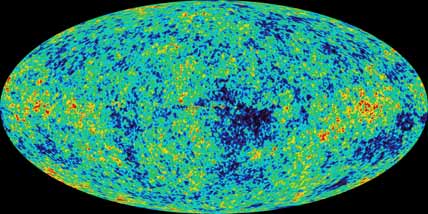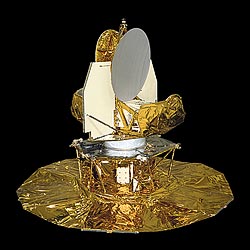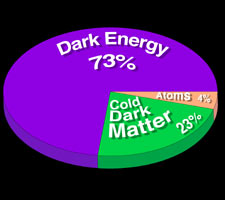
Thousands of slight temperature ripples, at scales large and small, mottle the microwave background radiation covering the sky. This all-sky map shows the first year of results from the WMAP mission. We're looking at slight irregularities in the early universe, seen 380,000 years after the Big Bang, that evolved to produce the galaxy clusters we see today.
Courtesy NASA / WMAP Science Team.
As of today we know better than ever when the universe began, how it behaved in its earliest instants, how it has evolved since then, and everything it contains.
At a NASA press conference in Washington, D.C., scientists released the much-anticipated first results from the Wilkinson Microwave Anisotropy Probe satellite, or WMAP. The big news is actually no news — and to astronomers, that's good news. WMAP has powerfully confirmed the conclusions that many teams of astronomers had already reached in recent years using instruments carried by balloons and on the ground.

The Wilkinson Microwave Anisotropy Probe, 3.8 meters (12.5 feet) tall, has twin microwave dishes and receivers that precisely compare the temperatures of 20-arcminute-wide spots widely separated on the sky. It has just been renamed for Princeton cosmologist David T. Wilkinson, who died last September; formerly it was named MAP.
Computer rendering courtesy NASA and the WMAP Science Team.
Launched in June 2001, WMAP flew to the vicinity of the L2 Lagrangian point, 1.5 million kilometers away from Earth's warmth and noisy interference. From there it has been mapping the cosmic microwave background radiation that fills the sky. The microwave background is the white light from the white-hot early universe 380,000 years after the Big Bang. Since that time the light's wavelength has been redshifted (lengthened by the expansion of space) by a factor of 1,100, bringing it into the microwave region of the spectrum.
The background radiation is very uniform across the sky — but not perfectly so. It is filled with weak ripples, first discovered 11 years ago, that differ in temperature by no more than a few parts per 100,000 from one place to another. These ripples resulted from oscillations and turbulence during the universe's earliest times. Their sizes and strengths as seen on the sky today tell volumes about the origin of the universe, its age, shape, and overall contents.
Astronomers originally thought that the ripples ("anisotropies") could be measured well only from space, and NASA planned the WMAP mission accordingly. In the meantime, however, dozens of teams have been racing to measure them using instruments on mountaintops, on the Antarctic plateau, and in the upper atmosphere. These experiments have covered only small patches of sky, while WMAP has surveyed the entire celestial sphere. And many have lacked WMAP's sensitivity or resolution and its ability to remove foreground contamination, such as from the Milky Way. However, the detector technology has advanced so much in just the last few years, and so many experiments have filled in each other's gaps, that the ground-based experiments beat WMAP to most of its major conclusions. So its results, once expected to be revolutionary, are now mostly confirmations.
Among WMAP's findings:

Everything in the universe. Normal 'baryonic' matter — in other words everything made of atoms, which are mostly protons and neutrons (baryons) — amounts to only about 4.4 percent of the total cosmic matter-and-energy budget. The other 95.6 percent is made of mysteries.
Courtesy NASA / WMAP Science Team.
"Every astronomer will remember where they were when they first heard the results from WMAP," said John Bahcall (Institute for Advance Study) at the press conference. The currently favored model of the universe "has been confirmed by WMAP with exquisite detail."
Today's results come less than halfway through WMAP's scheduled four-year mission and are based on just its first year of data. The craft's continuing measurements should refine the picture as time goes on.
Already, however, cosmologists are looking toward the next big step: The European Space Agency's Planck mission. It will bring much greater resolution and sensitivity to the task and may detect another type of signal: much more detailed polarization patterns in the microwaves. Planck may map these well enough for cosmologists to determine explicitly how inflation worked, and thereby to get a glimpse into the larger, underlying pre-existence outside of our universe from which the Big Bang sprang. Planck is due for launch in early 2007.
 0
0









Comments
You must be logged in to post a comment.